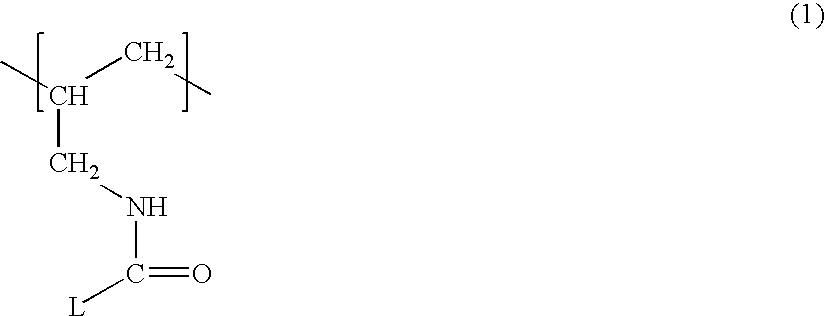Method for applying a coating onto a silicone hydrogel lens
a technology of silicone hydrogel and coating, applied in the field of soft silicone hydrogel contact lenses, can solve the problems of corneal swelling, inability to easily circumvent oxygen, and undesirable growth of blood vessels in the cornea, and achieve the effect of increasing hydrophilicity and increasing hydrophilicity
- Summary
- Abstract
- Description
- Claims
- Application Information
AI Technical Summary
Benefits of technology
Problems solved by technology
Method used
Image
Examples
example 1
Surface Hydrophilicity (Wettability) Tests
[0113]Water contact angle on a contact lens is a general measure of the surface hydrophilicity (or wettability) of the contact lens. In particular, a low water contact angle corresponds to more hydrophilic surface. Average contact angles (Sessile Drop) of contact lenses are measured using a VCA 2500 XE contact angle measurement device from AST, Inc., located in Boston, Mass. This equipment is capable of measuring advancing or receding contact angles or sessile (static) contact angles. The measurements are performed on fully hydrated contact lenses and immediately after blot-drying.
Coating Intactness Tests
[0114]The intactness of a coating on the surface of a contact lens can be tested according to Sudan Black stain test as follow. Contact lenses with a coating (an LbL coating, a plasma coating, or any other coatings) are dipped into a Sudan Black dye solution (Sudan Black in vitamin E oil). Sudan Black dye is hydrophobic and has a great tende...
example 2
[0125]Six buffers are prepared to investigate the effect of urea levels on the final pH of the buffer after autoclave. The buffers are adjusted to an initial pH of 2.5 with HCl (1 N). The buffers are placed in crimped vials and autoclaved for 45 minutes at 121° C. The buffer formulations and the post-autoclave pH are shown in Table 1.
TABLE 1post-Citric AcidTrometh-PolyacrylicautoclaveMonohydrateGlycerolamineacidUreapH0.21%2%0.30%0.01%0.05%3.870.21%2%0.30%0.01%0.10%5.150.21%2%0.30%0.01%0.30%6.800.21%2%0.00%0.01%0.05%3.760.21%2%0.00%0.01%0.10%5.250.21%2%0.00%0.01%0.30%6.54
example 3
[0126]Eight buffers are prepared to have varying levels of urea and tromethamine (Tris). The buffers are adjusted with HCl (1 N) to an initial pH of 2.5. Polyurea contact lenses, which are prepared as described in Example 4 of a co-pending U.S. Patent Application Publication No. 2007-0195261A1 (herein incorporated by reference in its entirety), are packaged in the buffers and autoclaved for 45 minutes at 121° C. The lenses appears more wettable than un-coated control lenses. The pH of the buffers is measured immediately after autoclaving and 45 minutes after opening the packages to allow the buffer to be equilibrated with the atmosphere. The pH increases after the packages are allowed to equilibrate with the atmosphere. It is believed that this phenomenon is likely due to loss of dissolved CO2 in the buffers. The post-autoclave and equilibrium pH are shown in Table 2.
TABLE 2Citric Acidpost-MonohydrateGlycerolTrisPAAUreaautoclaveequilibrium(%)(%)(%)(%)(%)pHpH0.212.00.070.0250.206.256...
PUM
| Property | Measurement | Unit |
|---|---|---|
| Angle | aaaaa | aaaaa |
| Substance count | aaaaa | aaaaa |
| Fraction | aaaaa | aaaaa |
Abstract
Description
Claims
Application Information
 Login to View More
Login to View More - R&D
- Intellectual Property
- Life Sciences
- Materials
- Tech Scout
- Unparalleled Data Quality
- Higher Quality Content
- 60% Fewer Hallucinations
Browse by: Latest US Patents, China's latest patents, Technical Efficacy Thesaurus, Application Domain, Technology Topic, Popular Technical Reports.
© 2025 PatSnap. All rights reserved.Legal|Privacy policy|Modern Slavery Act Transparency Statement|Sitemap|About US| Contact US: help@patsnap.com



